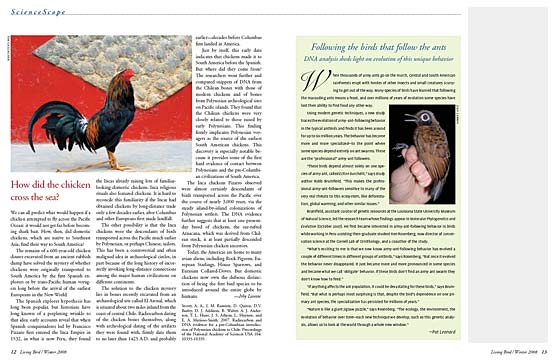Following the Birds That Follow the Ants
By Irby Lovette January 15, 2008

When thousands of army ants go on the march, Central and South American rainforests erupt with hordes of other insects and small creatures scurrying to get out of the way. Many species of birds have learned that following the marauding ants means a feast, and over millions of years of evolution some species have lost their ability to find food any other way.
Using modern genetic techniques, a new study traces the evolution of army-ant-following behavior in the typical antbirds and finds it has been around for up to six million years. The behavior has become more and more specialized—to the point where some species depend entirely on ant swarms. These are the “professional” army-ant followers.
“These birds depend almost solely on one species of army ant, called Eciton burchellii,” says study author Robb Brumfield. “This makes the professional army-ant-followers sensitive to many of the very real threats to this ecosystem, like deforestation, global warming, and other similar issues.”
Brumfield, assistant curator of genetic resources at the Louisiana State University Museum of Natural Science, led the research team whose findings appear in Molecular Phylogenetics and Evolution (October 2007). He first became interested in army-ant-following behavior in birds while working in Peru assisting then-graduate student Ken Rosenberg, now director of conservation science at the Cornell Lab of Ornithology, and a coauthor of the study.
“What’s exciting to me is that we now know army-ant-following behavior has evolved a couple of different times in different groups of antbirds,” says Rosenberg, “But once it evolved the behavior never disappeared. It just became more and more pronounced in some species and became what we call ‘obligate’ behavior. If these birds don’t find an army ant swarm they don’t know how to feed.”
“If anything affects the ant population, it could be devastating for these birds,” says Brumfield. “But what is perhaps most surprising is that, despite the bird’s dependence on one primary ant species, the specialization has persisted for millions of years.”
“Nature is like a giant jigsaw puzzle,” says Rosenberg. “The ecology, the environment, the evolution of behavior over time—each new technique we develop, such as this genetic analysis, allows us to look at the world through a whole new window.”


All About Birds is a free resource
Available for everyone,
funded by donors like you



